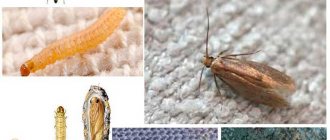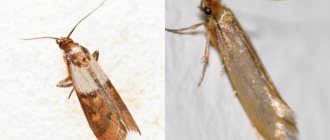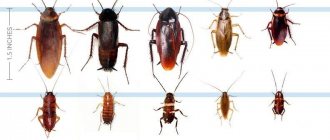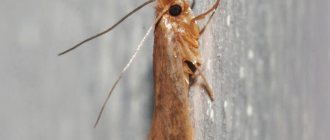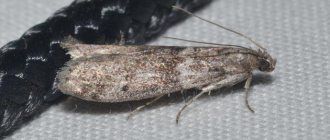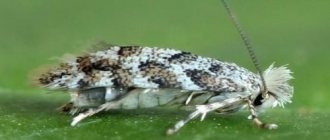Small gray moths not only cause inconvenience and considerable discomfort by their very existence in an apartment, they can cause significant harm: ruin dresses made from natural fabrics, expensive fur coats, and food. Getting rid of moths is difficult. It is much better to prevent pests from appearing in the house than to deal with an invasion.
A variety of folk remedies for moths will help not only get rid of gray moths, but also prevent the appearance of moths. Traditional methods of controlling household pests are sometimes in no way inferior to modern scientific achievements.
Features of the use of folk remedies
Before you understand how to get rid of moths using folk remedies, it is important to understand what type they are. Almost all folk remedies are aimed at repelling pests, but are not capable of destroying them. In addition, when choosing a folk remedy, you should take into account that some can be adjacent to food, while others are better used where food supplies are not available.
Almost always in the household you can find something that moths are afraid of, and not give it the opportunity to reproduce in the apartment. But even if the necessary component is not available, it can always be easily purchased without a significant impact on the family budget. If the fight is not started in time, this parasite will quickly multiply and ultimately ruin all food supplies or valuable wardrobe and household items.
Citrus peels
Orange or lemon peels are a traditional folk remedy against moths. Their strong smell is not to the liking of adults. Therefore, in every section of the cabinet where orange peels are laid out, butterflies will not dare to lay eggs. Tangerine peels have a similar effect.
Citrus peels
To obtain the desired effect, the peel of a tangerine or orange must be fresh; it is important to prevent it from drying out or developing mold. Since dry citrus peels do not have a strong aroma, they will not protect against pests. Therefore, they need to be changed regularly.
Important! You can use tangerine or orange peels only for preventive purposes, since they are not capable of getting rid of moth larvae that have already settled in a fur coat.
How to get rid
If a moth butterfly flies around the apartment during the daytime, then most likely it is a male. Swatting an insect is not the best way to protect your living space from this pest. This is due to the fact that the female is already quietly laying eggs somewhere, from which hungry larvae will soon hatch. Therefore, in order to get rid of uninvited guests, you need to find the most effective folk remedies for moths.
In the closet
Quite often, the presence of a pest in a wardrobe is discovered after holes appear on expensive woolen items. The larvae of such insects can be brought from the street. It is possible to avoid the proliferation of moths if you put into the closet only those clothes that have been pre-washed or thoroughly cleaned after use.
But even if, despite carefully caring for things, pests still appear in the closet with clothes, then everything needs to be reconsidered again, washed and ironed. And fur products should be taken out into the fresh air several times a year under direct sunlight or frost, which this insect is so afraid of.
After putting things in order, they cannot be immediately sent to the closet.
It must first be treated with a solution of laundry soap. After all the compartments and shelves have dried, you can return the wardrobe items to their original place. For moths in the closet, it is advisable to place repellent folk remedies on the shelves.
This effect is achieved by:
- laundry soap in the cupboard;
- orange peels;
- lavender, mint, chamomile, tansy, wormwood
If there are no folk remedies at home to protect against this insect, then you can use any scented toilet soap. Bars of soap along with wrappers are laid out in cabinets.
In the apartment
To destroy carpet or furniture moths, you need to prepare a concentrated soap solution, which is used to treat the damaged carpet on both sides, as well as upholstered furniture. After such cleaning, the pile of the products becomes tougher, but this method is guaranteed to get rid of unpleasant insects.
To repel carpet moths, you can use high or low temperatures (sun or frost). Experienced housewives know that folk remedies for moths in an apartment include taking carpets out into the cold in winter to thoroughly clean them with snow. In summer, it is recommended to hang carpets in the sun and dry them thoroughly, which will allow you to confidently get rid of pests.
Moths can not only be localized on carpets; they also love down pillows, blankets and rugs. Some people get out of this situation by regularly sending such items to the dry cleaner or drying them in the fresh air. In any case, pillows and blankets that are not used daily should be checked regularly so that insects do not have time to breed in them. They can also be arranged with pieces of soap or bags of herbs.
Among the plants that repel the pest are coleus and geranium. The smell of tobacco, pepper, dried orange peels, and strawberry soap also repels such insects. In addition to plants, most well-known spices also have a pungent odor - allspice, cloves, vanilla, cinnamon. To repel the pest for a long time, it is recommended to fill bags with spices and place them around the apartment.
In the kitchen
You can bring this type of moth home from stores or markets where unscrupulous sellers sell bulk food products already with larvae.
The grain species is capable of multiplying very quickly. He can easily do this in sealed bags or glass jars with lids.
When faced with food moths in the kitchen, where they can be found in many cereals, the first thing you should do is throw away everything that is already spoiled. Cereals without larvae must be sifted and fried in a hot frying pan to ensure the destruction of the pest. In addition, cabinets and kitchen surfaces must be thoroughly washed with a solution of laundry soap, rinsed with clean water and dried.
Folk remedies for moths in the kitchen include the use of garlic. Slices of this phytoncide are stored in bedside tables, kitchen cabinets or pantries along with food products. When the clove dries out, it is advisable to replace it with a fresh one.
You can scare away pests in the following popular ways:
- Place lemon, orange or grapefruit zest, bags of lavender or other herbs next to the food.
- Essential oils (lemon, rosemary, lavender) have a good repellent effect. Some people also use laundry or scented soap.
- Spices that have a strong aroma (cloves, allspice, cinnamon, oregano, mint) will help repel. Spices can be poured onto a saucer and placed inside the kitchen cabinets.
Since groceries actively absorb odors, not all folk recipes are suitable for use.
Vinegar and garlic
Vinegar and garlic do not have a very pleasant smell. Although it is precisely because of it that they are considered a good means of fighting insects. It is better to store garlic in the kitchen, inside cabinets or in pantries next to other food products, and it is recommended to add vinegar to the water when cleaning the floor in the apartment.
The butterfly does not tolerate spicy plants, including thyme, rosemary and cloves. They can be placed in bags, combined with each other, or used each separately. Such sets are distributed throughout the apartment and repel pests from the premises for a long period.
Lavender against moths
A time-tested remedy is lavender for moths. Both lavender essential oil and dried branches are used. Lavender essential oil is present in perfumes, toilet soaps, skin care products, and hair care products. At the same time, moths cannot tolerate the smell of lavender.
How it helps
Lavender against moths can be a beautiful solution to the problem. Lavender helps against moths no worse than mothballs, but at the same time it gives the closet and things a pleasant light aroma. In addition, lavender bouquets look like pleasant decorative elements. Moths cannot stand the smell of this beauty, so they will not settle in places where this aroma is heard.
The plant has a long-lasting effect and is completely safe for humans.
How to use
If housewives have chosen lavender for moths, there are several ways to use it. All you have to do is turn on your imagination. It is recommended to add 20 drops of lavender essential oil to 1 liter of water during wet cleaning and wipe cabinets and other surfaces.
If you have lavender flowers, you can make a sachet and put it on the wardrobe. If you don’t have bouquets of lavender, then lavender essential oil for moths can be a good substitute. The housewife can sew a simple bag herself and fill it with cotton wool previously soaked in essential oil. This will not only serve as good protection against moths, but will also look aesthetically pleasing.
Lavender and other essential oils
The scents of concentrated essential oils are effective in fighting moths. The most common remedy is lavender. The plant can be used dried or as an essential oil. Dried flowers and leaves are laid out in porous bags, placed between piles of clothes or in kitchen cabinets, aromatic essential oil is placed there in open containers.
Like dry lavender, you can also place small pads of other herbs on the shelves. Wormwood, cloves, valerian, marigold, chamomile or tansy are suitable.
You can also use essential oils from the following plants:
- mint;
- carnation;
- rosemary;
- lemon;
- eucalyptus;
- orange.
Oily substances can not only be placed on cabinet shelves in open containers. They are also used as follows:
- cotton swabs are moistened with aromatic oil and laid out in kitchen or clothing cabinets;
- wash the floor or wipe surfaces with water and a few drops of essential oil;
- The room, cabinets and upholstered furniture are sprayed with a spray bottle.
What else is a moth afraid of?
In the housewife's attempts to find what the moth is afraid of (folk remedies), she may find the following recommendations for use:
- indoor plants with a strong odor;
- spicy medicinal plants;
- some fruits;
- essential oils;
- synthetic drugs in the form of suspended elements.
When fighting flying pests in an apartment, you should remember that it is not the butterfly that spoils food and things, but its larvae, deposited in secluded places deprived of access to fresh air. You will have to get rid of them yourself or using chemicals.
A variety of folk remedies only repel such insects. If there are already too many of them, you may need to resort to chemical insecticides. The larvae die from them and this guarantees complete disposal of the pest once and for all.
Advantages and disadvantages
The advantages of using lavender culture as a means of combating harmful butterflies include:
- strong but pleasant smell that lasts a long time;
- placing lavender pads and dried bouquets not only repels moths, but also fills things with a delicate aroma;
- long lasting effect;
- safe for humans and pets;
- almost does not cause allergies and various adverse reactions (unlike chemicals);
- environmental friendliness of the method;
- ease of use: just place ready-made or self-made pads in cabinets - and effective prevention of moths is guaranteed.
However, this method has one drawback - if there are a lot of moths in the house, then it will take a lot of time to completely get rid of them using only lavender. The insects will not fly away immediately.
What plants will help fight moths?
Many plants are used to get rid of moths. Most of them have a rather rich, but pleasant aroma for humans, so their use not only does not cause inconvenience to household members, but also makes the atmosphere in the house more comfortable.
Wild, garden and indoor plants help control pests.
Wild growing
Plants that repel moths contain essential oils. It is their scent that the moth senses. The highest concentration of esters can be in different parts of the plant: stems, roots, flowers, leaves, seeds. For the greatest effect, use those parts where there is the most oil.
Caucasian chamomile
Caucasian (or Dalmatian) chamomile has long been used to combat insects. When choosing which plant repels moths, many choose pyrethrum. Powder from dried and crushed flowers is scattered in the room where pests were noticed. A few grams of product are enough for one room.
Fragrant tobacco
The smell of fragrant tobacco, which repels moths, is pleasant to humans. Dried flowers can be placed in canvas bags. And they, in turn, are placed in cabinets and on shelves. The flower can be planted at home, then it will not only annoy insects, but also decorate the interior.
Lavender
Lavender is one of the most popular remedies not only for moths, but also for other insect pests. The vast majority of people like the scent of lavender, but the vast majority of insects cannot stand it. You can use fresh or dried flowers to control pests. Considering that their smell is not only rich, but also persistent, dry lavender helps get rid of insects for 1.5 - 2 months. Only after this the aroma runs out and the sachet or bouquet must be replaced.
The fresh spicy smell of mint refreshes the air and has a beneficial effect on the human nervous system. This is why many people willingly use grass to repel moths and other insects. You can grow mint in a pot or dry it and put it in bags. The product is effective as long as the smell remains.
Wormwood
Wormwood is another herb that is often used to get rid of moths. Insects simply cannot stand the specific bitter smell and try to get as far away from it as possible. Wormwood is collected, dried in a dark, cool place, and then crushed and scattered into sachets or bags, which are placed on shelves, in drawers, and in clothing pockets.
Oregano
Oregano or oregano is a herbaceous plant with a bright spicy aroma. People use it to prepare cold and hot dishes and for preservation. This strong-smelling herb is also used to control insects. If you plant oregano at home, there will always be fresh seasoning in the kitchen even in the absence of moths.
Tansy
Tansy is a plant that can be found almost everywhere. It grows along roads, in meadows, garden plots, and forest edges. Since ancient times, bright yellow inflorescences have been used to repel insects. Despite the fact that the smell of tansy is barely perceptible to humans, moths cannot stand it.
Rosemary
Rosemary is another herb that doubles as an insect repellent. The aromatic herb is indispensable for preparing salads and fish dishes. This plant also helps rid the house of moths. A few fresh or dried twigs are enough to get pests out of the kitchen. The only drawback is that the scent of rosemary disappears quite quickly.
horse chestnut
Chestnut fruits are an effective remedy for moths. People don’t even feel the smell, which insects don’t like so much that they are ready to change their place of residence to a new one, just not to smell it. Fresh fruits quickly become moldy, so they need to be dried in the oven. After that, they are laid out on closet shelves or in clothing pockets.
House plants from moths
Some indoor plants also help fight unwanted neighbors - insects. Flowers in pots perform several functions at once: they decorate the house, purify and deodorize the air, and repel pests.
Geranium
Geranium is perhaps the most famous and popular indoor flower, which is used to get rid of moths. Lush flowers in all shades of pink, red, and purple look great in any setting. They look equally harmonious both in the kitchen and in the room, and will also help drive away both food and clothes moths.
The aroma of geranium (regardless of the variety) is unbearable for insects. For greater effect, you should periodically leave the cabinet doors open so that the smell penetrates inside.
An elegant tree with emerald green leaves and delicate white flowers is grown by many at home. Essential oils give myrtle a pleasant and rather strong aroma with pronounced citrus notes. The smell hovering where the plant is located has an adverse effect on the moth, and the insect tends to leave the room as quickly as possible.
Lily
Beautiful noble lilies are a decoration for any garden, but there are many varieties for home maintenance. These include the popular amaryllis, hippeastrum, and Amazon lilies. The delicate aroma of these flowers evokes only pleasant sensations in people, but moths do not stay long in a room with lilies.
Plectranthus
Plectranthus or indoor mint is another natural repellent that repels moths. This is a very beautiful plant with large drooping leaves. Depending on the type, the color can be monochromatic (all shades of green) or interspersed with white, burgundy, lilac, and gray.
The aroma of plectranthus is a fragrant combination of lemon and mint. Insects tolerate such a pleasant combination for humans very poorly, and therefore fly away from it.
Preventing the appearance of moths in the apartment
Folk remedies are actively used to prevent the appearance of pests in the house. But herbs alone are not enough. To prevent moths from getting into your home, you need to follow a few simple recommendations:
- things folded and hanging in closets should not be compacted tightly; there should be free space between them;
- It’s worth periodically checking your wardrobe;
- before storing seasonal clothing, it must be cleaned and dried properly;
- It is advisable to shake out fur products periodically; it is best to do this in the fresh air;
- store bulk products in tightly closed glass or metal containers;
- Place sachets with herbs that repel moths in cabinets, on mezzanines and kitchen shelves.
Frequent ventilation and regular cleaning will protect the house not only from dirt, but also from insects.
Laundry soap
An excellent folk remedy for moths in the closet is laundry soap. Both clothes and kitchen moths are afraid of its smell. The principle of use is quite simple: you need to place bars of scented soap in the closet between things or products. You can also treat all interior surfaces of furniture cabinets with soapy water.
Review
“To get rid of moths, I used laundry soap on the advice of my mother and reviews from a friend. I treated both the closet, which was favored by insects, and other places where clothes were stored for prevention. Afterwards I left small pieces of soap in the cabinets. Moths don’t bother me anymore!”
Inna, Ryazan
Naphthalene
Naphthalene is truly a folk remedy. Its effect in the fight against moths has been known since the time of our grandmothers. However, the latest research has proven that the drug contains carcinogenic substances that are unsafe for human health. Therefore, naphthalene was not used to kill food moths, since the products are capable of absorbing odors.
They began to use naphthalene against moths only in closets, laying it out on shelves, in bags with woolen items, in the pockets of coats and fur coats.
Species living in residential areas
To get rid of uninvited guests, you need to know exactly where they are located: this is where the larvae are located, which cause serious damage.
And since there are several types of pests that live in residential areas, you should initially recognize the type of flying insect, which will significantly narrow the search area.
The moth belongs to the family of Lepidoptera butterflies, of which there are about 3 thousand species in nature. But separate varieties appear in residential areas.
Clothes
Favorite habitats are closets, boxes or baskets with linen, chests of drawers, closets, and all places used for storing clothes. Insects are attracted by the smell of human sweat, so the habit of leaving laundry until later can lead to the massive spread of this species.
The pest prefers to feast on woolen and knitted fabric fibers, but mixed products also tempt it. There is no need to worry about synthetic clothing.
The clothes moth is gray-brown in color. When you touch the wings, pearl-colored pollen remains on your fingers. The wingbeat of the insect reaches 22 mm.
Fur coat
The difference between this variety is that the larvae feed on fur, felt and felt.
In this case, the pest carefully trims the pile at the base and then breaks it with its jaws. When he eats the required amount, he continues to spoil the product, paving the way to a new habitat.
The size of the fur moth is smaller than the clothes moth; its wingspan is 15-16 mm. The color is clay-yellow with a characteristic shiny sheen on top. The reverse side of the wings has a light gray tint.
Furniture
This type of butterfly prefers to settle in upholstered furniture, where the upholstery serves as food for the larvae. Initially, they eat the internal filling, and then gnaw tunnels and move on to the finishing material.
The transformation of larvae into butterflies occurs in special cocoons, which are placed on the underside of the upholstery. Insects also damage carpets and rugs.
Be sure to read:
White insects live in the toilet and bathroom: crawl, run fast, what to do
This species lacks oral tentacles. The color of the wings is silvery-yellow, and the head is dark yellow. The development of larvae occurs over 2-5 months, depending on the period of the year.
Fruity
This type of insect prefers the kitchen, pantry, and all those places where dried fruits are stored. The pest also causes damage to dried mushrooms, nuts, herbs, and roots.
The color is gray-brown, the wingspan reaches 8 mm.
Cereal
Prefers to eat flour, cereals, sugar, and animal feed. The grain variety is small in size and yellow-gray in color.
This allows insects to be thoroughly camouflaged in products, which makes it difficult to search at the first sign of damage. The larvae eat the upper layers of bulk products, turning them into dust. The body length reaches 9 mm, and the wingspan is 11-19 mm.
In addition to these species, there is a wax, potato, and cabbage variety, which appears much less frequently in the apartment.
Attention! The function of adult individuals is to lay eggs in favorable places, which will allow the voracious caterpillars to immediately find food.

